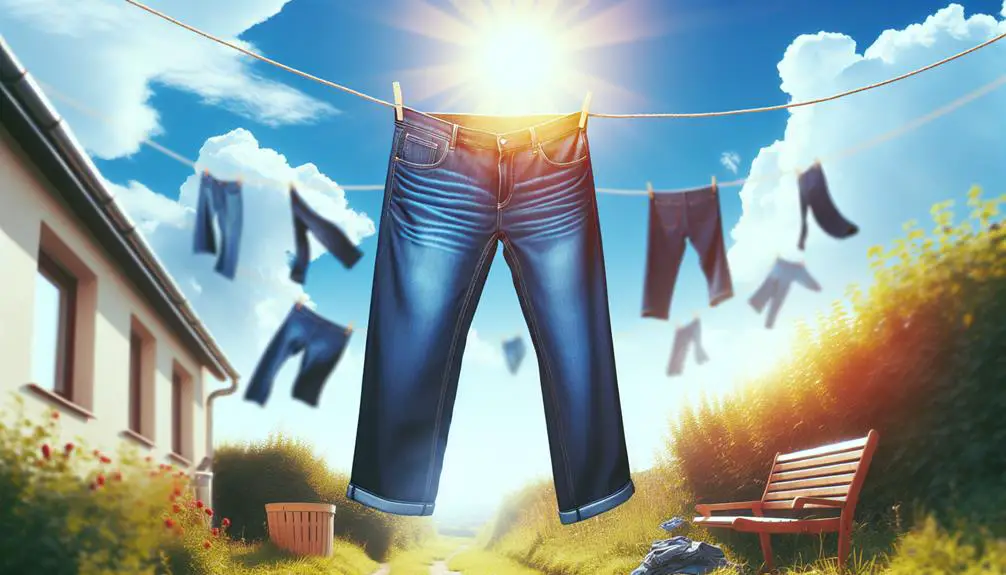Ever wondered how long those trusty denim jeans take to air dry?
Picture this: you've just washed your favorite pair, and now the countdown begins.
But before you start planning your outfit around them being ready, there are a few factors to consider that might affect the drying time.
Stay tuned to find out more about optimizing your air drying routine for those beloved blues.
Table of Contents
Key Takeaways
- Factors like fabric thickness and ventilation impact jeans' drying time.
- Optimal conditions include good air circulation and low humidity for quick drying.
- Proper air circulation prevents musty odors, aids even drying, and boosts evaporation.
- Denim's composition and water absorption affect the time jeans take to air dry.
Factors Affecting Jeans Drying Time
The thickness of the denim fabric significantly impacts how long it takes for jeans to air dry. When jeans have a heavier weight denim, they tend to retain more water, prolonging the drying process. This means that those favorite pair of thick denim jeans may take longer to dry compared to a lighter pair.
Additionally, the drying process for jeans is influenced by the ventilation in the area where they're drying. Proper ventilation is essential as it allows for better airflow, helping moisture evaporate more efficiently from the fabric.
Humidity levels in the air also play a crucial role in determining how quickly jeans air dry. High humidity can slow down the evaporation process, making it harder for the jeans to dry thoroughly. Conversely, direct sunlight can speed up the drying process for air-drying jeans by providing warmth and aiding in moisture removal.
Understanding these factors can help in optimizing the air-drying process for your jeans to ensure they dry efficiently and maintain their quality.
Best Practices for Air Drying
When air drying jeans, it's essential to follow these best practices for optimal results:
- Hang your jeans: To ensure even drying and prevent wrinkles, hang your jeans on a clothesline or drying rack. This method allows air to circulate around the jeans, aiding in the drying process.
- Choose a well-ventilated area: Placing your damp jeans in a well-ventilated space can help speed up the air drying process. Good airflow helps moisture evaporate more quickly, reducing drying time.
- Turn jeans inside out: Before air drying your jeans, turn them inside out. This simple step helps preserve the color and fit of the denim, as the outer part is protected from direct exposure to the air.
- Avoid direct sunlight: While drying your jeans outdoors is great, be cautious of direct sunlight. Prolonged exposure to the sun can fade the color of your denim, so it's best to find a shaded spot for air drying.
Optimal Drying Conditions for Jeans
When drying my jeans, I aim for the ideal drying environment – a well-ventilated area with proper air circulation.
It's crucial to hang jeans away from direct sunlight to preserve their color and shape.
Following these steps ensures that my favorite denim pieces dry efficiently and look their best.
Ideal Drying Environment
In the right setting, jeans can air dry comfortably within 4-6 hours, benefiting from warm, well-ventilated spaces with good airflow. To create the ideal drying environment for jeans, consider the following:
- Temperature: Ensure the area is warm enough to facilitate the drying process without being too hot to potentially damage the fabric.
- Ventilation: Good airflow helps moisture evaporate from the jeans efficiently, aiding in quicker drying times.
- Humidity Levels: Opt for low humidity settings to prevent dampness and mildew, promoting faster air drying.
- Air Circulation: Hang jeans in a spot with adequate air circulation to prevent musty odors and ensure even drying throughout the garment.
Proper Air Circulation
For optimal drying conditions when air drying jeans, ensuring proper air circulation is essential to expedite the process and prevent musty odors. Hanging your jeans in a well-ventilated area is key to efficient evaporation and faster drying times. Opting for a breezy outdoor location can further speed up the process, as the natural airflow aids in removing moisture from the fabric. Avoiding stagnant or enclosed spaces is crucial to allow the jeans to dry thoroughly and evenly. Here's a handy table summarizing the importance of proper air circulation in the air drying process:
| Proper Air Circulation Benefits |
|---|
| Faster drying times |
| Prevention of musty odors |
| Reduction of mildew growth |
| Even drying of the fabric |
| Enhanced evaporation efficiency |
Avoid Direct Sunlight
To maintain the color and integrity of your jeans while air drying, it's best to avoid exposing them directly to sunlight. Here are some tips to ensure your jeans dry effectively without risking color fading or damage:
- Shaded Drying: Find a shaded area outdoors or indoors to hang your jeans for air drying.
- Indoor Options: Opt for indoor air drying if you can't find a shaded spot outside to protect your jeans from direct sunlight.
- Cover Up: If outdoor drying is your only option, cover your jeans with a cloth or towel to shield them from direct sunlight.
- Rotate Positions: Periodically rotate the position of your jeans while drying to ensure even drying without prolonged exposure to sunlight.
How Weather Impacts Drying Time
When it comes to drying jeans, weather plays a crucial role in determining how long it will take for them to air dry.
Humidity levels can either speed up or slow down the drying process, affecting the overall time it takes for your jeans to be ready to wear.
On sunny, windy days, you can expect your jeans to dry much faster compared to cold, damp weather conditions.
Weather Conditions Affect Drying
During sunny days, direct sunlight can significantly accelerate the air drying process for jeans. When considering weather conditions that affect drying, the environment plays a crucial role in how quickly your jeans will dry. Here are some key points to keep in mind:
- Humidity Levels: High humidity levels can prolong the drying time for jeans, as moisture struggles to evaporate in damp conditions.
- Direct Sunlight: Sunlight can be a powerful ally in drying your jeans quickly, as the heat aids in moisture evaporation.
- Windy Conditions: Wind can help speed up the drying process by facilitating the evaporation of moisture from your jeans.
- Cold and Cloudy Weather: Conversely, cold and cloudy weather may slow down the air drying process, requiring more time for your jeans to dry properly.
Humidity Influences Drying Process
In the realm of air drying jeans, the level of humidity present in the environment plays a pivotal role in influencing the speed at which your denim garments dry. High humidity levels can significantly prolong the drying time, sometimes exceeding 24 hours for jeans to fully dry.
Conversely, in low humidity environments, the air drying process can be expedited. This is due to humidity directly impacting the evaporation rate of moisture from the jeans, affecting the overall drying speed.
To better gauge the drying timeline, monitoring humidity levels becomes crucial. By keeping an eye on the humidity in the air, one can more accurately estimate the time required for jeans to air dry effectively.
Tips for Faster Drying
To speed up the drying process for jeans, consider utilizing a fan or placing them in a well-ventilated area. Here are some tips for faster drying:
- Roll in a Towel: After washing your jeans, gently roll them in a clean towel to soak up excess water. This can significantly reduce drying time by starting the process with less moisture.
- Utilize High Heat Settings: If using a dryer, select a higher heat setting. This will help evaporate the water from the fabric more quickly, speeding up the drying process.
- Hang in Direct Sunlight: Hanging your jeans outside in direct sunlight can harness the natural warmth and airflow to dry them faster. The combination of sunlight and fresh air can cut down drying time to as little as 1-2 hours.
- Dehumidify the Area: Using a dehumidifier in the drying space can decrease humidity levels, creating a more conducive environment for quick air drying. Lower humidity means moisture evaporates faster from the jeans.
The Role of Fabric Type
After exploring tips for faster drying, understanding the role of fabric type in the air drying process is crucial for effectively caring for different clothing items.
When it comes to denim jeans, their unique composition plays a significant role in how they dry. Denim is a sturdy fabric that can retain moisture, making it take longer to air dry compared to lighter materials like silk.
The thickness of denim jeans means they require more time to fully dry, with outdoor drying typically taking around 4 hours and indoor drying possibly extending up to 24 hours. Exposing denim jeans to excessive heat during the drying process can also alter their shape and fit, so it's important to allow them to dry naturally.
Understanding Denim Absorbency
When it comes to denim, understanding how it absorbs water can be key to predicting drying times.
The properties of denim fabric, such as cotton content and thickness, play a significant role in how much water it can hold.
Factors like humidity levels and stretch materials also impact how quickly your favorite pair of jeans will be ready to wear again.
Denim Fabric Properties
Exploring denim fabric properties reveals the unique absorbency traits that contribute to its prolonged air drying time.
- Denim's low absorbency compared to other fabrics results in extended drying periods.
- The thickness and weave of denim play a significant role in retaining moisture within its fibers.
- The absorbent nature of denim stems from the cotton fibers it comprises, which retain water molecules.
- Efficient air circulation is crucial to speeding up the drying process of denim, as stagnant air can hinder evaporation.
Understanding these properties helps in comprehending why denim takes longer to air dry compared to other materials. Factors like humidity, temperature, and airflow further influence the drying time of denim garments.
Water Absorption Rate
Denim's prolonged air drying time can be attributed to its unique water absorption rate, a key factor in understanding the fabric's absorbency. Denim jeans can absorb up to 27% of their weight in water, with factors like fabric composition and thickness influencing the absorbency rate. Thicker denim fabrics may take longer to air dry due to higher water retention. The weave and quality of denim also play a role in how quickly jeans release moisture during air drying. Understanding the water absorption rate of denim is crucial in predicting the time required for jeans to dry naturally.
| Water Absorption Rate | Air Drying Time | Fabric Composition | Denim Quality |
|---|---|---|---|
| Up to 27% of weight | Influences time | Varies | Impacts speed |
Drying Time Factors
Understanding the factors that influence the drying time of denim jeans is essential for efficiently managing the air drying process. When considering how long it will take for your jeans to air dry, factors such as humidity, fabric thickness, weave, and dye all come into play. Here are four key elements to keep in mind:
- Humidity Levels: Higher humidity levels can prolong the drying time of jeans.
- Fabric Characteristics: The thickness, weave, and dye of the denim can impact how quickly the jeans dry.
- Wringing Out Excess Water: Properly wringing out excess water before air drying can significantly reduce drying time.
- Air Circulation: Hanging your jeans in a well-ventilated area with good air circulation can help expedite the drying process.
Efficient Drying Methods
To dry jeans efficiently, consider utilizing optimal drying methods to speed up the process. One effective method is to properly wring out the jeans before air drying, as this can significantly reduce drying time. Additionally, hanging jeans in a warm, well-ventilated room with good air circulation can help expedite the drying process. Direct sunlight can also be beneficial in speeding up the drying of denim jeans due to the heat it provides.
Efficient Drying Methods:
| Method | Description |
|---|---|
| Wring out jeans before air drying | Helps reduce drying time significantly |
| Hang in a warm, well-ventilated room | Facilitates faster drying with good air circulation |
| Utilize direct sunlight for quicker drying | The heat from the sun can speed up the drying process |
Avoiding Common Drying Mistakes
After learning efficient drying methods for jeans, let's now steer clear of common mistakes that can hinder the drying process.
- Avoiding Direct Heat: Placing jeans near direct heat sources like radiators or heaters can cause shrinkage and damage the fabric. Opt for gentle air drying instead.
- Overcrowding: Hanging too many jeans on a single line can restrict airflow, leading to longer drying times. Space them out adequately for optimal drying.
- Ignoring Fabric Thickness: Thicker denim or layered jeans require more time to dry thoroughly. Be patient and allow them the necessary time to air dry completely.
- Skipping Turnovers: For even drying, flip the jeans inside out periodically during the drying process. This ensures both the inside and outside of the fabric dry evenly.
Testing Jeans for Dryness
When checking jeans for dryness, it's essential to employ multiple senses to ensure they're thoroughly air-dried. Start by checking the weight of the jeans; if they still feel heavy, they likely retain moisture.
Feeling the fabric can also provide valuable information – dampness or cold spots indicate that more drying time is needed. Visual cues play a significant role; look for any changes in color or shrinkage as signs of progress.
A musty or damp odor suggests lingering moisture, indicating the jeans aren't yet fully dry. A touch test can confirm dryness – press on the fabric to detect any residual dampness.
Frequently Asked Questions
How Can I Make My Jeans Air Dry Faster?
To make my jeans air dry faster, I find a warm, well-ventilated spot with good airflow. Hanging them outdoors in the sun speeds things up. Wringing out excess water and using a fan indoors also help quicken the process.
Is It OK to Air Dry Jeans?
Is it ok to air dry jeans? Absolutely! Air drying helps preserve the fabric, prevents shrinking, and maintains color. I find it convenient and effective. Plus, it's eco-friendly and extends the lifespan of my favorite denim pieces.
How Do You Air Dry Jeans Indoors?
To air dry jeans indoors, I hang them on a drying rack or clothesline, turning them inside out to maintain color and fit. Placing damp jeans on a towel helps speed up drying. Using a fan can quicken the process.
How Can I Dry My Jeans Without a Dryer?
I hang my jeans indoors or outside when I want to air dry them without a dryer. Proper wringing and good ventilation help. It usually takes about 4-24 hours, depending on where I dry them.
- Is Velvet Breathable? Understanding Comfort for Clothing & Upholstery - June 22, 2025
- Working With Velvet Fabric: Essential Tips for Crafters & Designers - June 22, 2025
- Sewing Stretch Velvet Fabric: Handling Knit Pile Textiles - June 22, 2025







